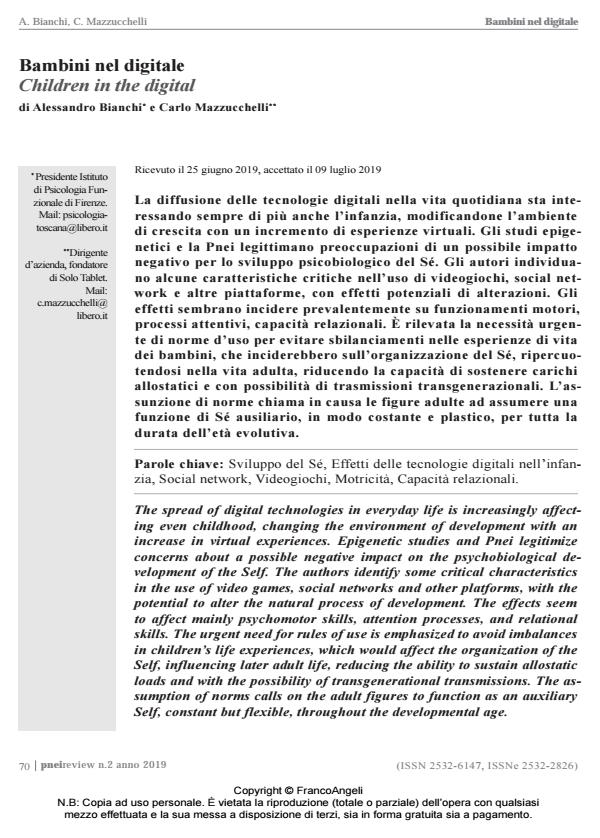Children in the digital
Journal title PNEI REVIEW
Author/s Alessandro Bianchi, Carlo Mazzucchelli
Publishing Year 2019 Issue 2019/2 Language Italian
Pages 12 P. 70-81 File size 145 KB
DOI 10.3280/PNEI2019-002007
DOI is like a bar code for intellectual property: to have more infomation
click here
Below, you can see the article first page
If you want to buy this article in PDF format, you can do it, following the instructions to buy download credits

FrancoAngeli is member of Publishers International Linking Association, Inc (PILA), a not-for-profit association which run the CrossRef service enabling links to and from online scholarly content.
The spread of digital technologies in everyday life is increasingly affecting even childhood, changing the environment of development with an increase in virtual experiences. Epigenetic studies and Pnei legitimize concerns about a possible negative impact on the psychobiological development of the Self. The authors identify some critical characteristics in the use of video games, social networks and other platforms, with the potential to alter the natural process of development. The effects seem to affect mainly psychomotor skills, attention processes, and relational skills. The urgent need for rules of use is emphasized to avoid imbalances in children’s life experiences, which would affect the organization of the Self, influencing later adult life, reducing the ability to sustain allostatic loads and with the possibility of transgenerational transmissions. The assumption of norms calls on the adult figures to function as an auxiliary Self, constant but flexible, throughout the developmental age.
Keywords: Development of the Self, Digital technologies effects in childhood, Social networks, Video games, Motor skills, Social interaction skills.
- Adami R., Pagano J., Colombo M., Platonova N., Recchia D., Chiaramonte R., Bottinelli R., Canepari M. and Bottai D. (2018). Reduction of Movement in Neurological Diseases: Effects on Neural Stem Cells Characteristics. Front. Neurosci., 12: 336.
- Bansal A., Weech S. and Barnett-Cowan M. (2019). Movement-Contingent Time Flow in Virtual Reality Causes Temporal Recalibration. Sci Rep., 9: 4378.
- Bianchi A. (2016). La grammatica della vita è sensomotoria. PNEI News, 3-4: 13-16.
- Bianchi A. and Mazzucchelli C. (2018). Tecnologie e sviluppo del benessere psicobiologico. Milano: Delos Digital.
- Cole S.W. (2014). Human Social Genomics. PLoS Genetics, 10(8): e1004601.
- Common Sense Media (2017). The Common Sense Census: Media Use by Kids Age Zero to Eight. -- Testo disponibile al sito: www.commonsensemedia.org/research/the-common-sense-censusmedia-use-by-kids-age-zero-to-eight-2017, visitato il 15/06/2019.
- Damasio A. (2010). Self comes to mind: constructing the conscious brain. London: Phantheon book.
- Fiuza-Luces C., Garatachea N., Berger N.A. and Lucia A. (2013). Exercise is the Real Polypill. Physiol., 28(5): 330-358.
- Fonagy P., Gergely G. and Target M. (2008). Costrutti psicoanalitici, teoria dell’attaccamento e ricerca. In Cassidy J. and Shaver P.R., eds., Manuale dell’attaccamento. Teoria, ricerca e applicazioni cliniche. Roma: Giovanni Fioriti Editore, pp. 902-931.
- Howett D., Castegnaro A., Krzywicka K., Hagman J., Marchment D., Henson R., Rio
- M., King J., Burgess N. and Chan D. (2019). Differentiation of mild cognitive impairment using an entorhinal cortex-based test of virtual reality navigation. Brain, 142(6): 1751-1766.
- Kandel E.R. (2018). La mente alterata. Milano: Raffaello Cortina.
- Kandel E.R., Dudai Y. and Mayford M.R. (2014). The Molecular and Systems Biology of Memory. Cell, 157(1): 163-186.
- Lee C. and Wong G.K.C. (2018). Virtual reality and augmented reality in the management of intracranial tumors: A review. J. Clin. Neurosci., 62: 14-20.
- jocn.2018.12.036 Mazzucchelli C. (2018). Era digitale: indagine su potenzialità e danni. -- Testo disponibile al sito: https://www.solotablet.it/blog/tabulario/era-digitale-indagine-su-potenzialita-e-danni, visitato lo 02/07/2019.
- Microsoft (2015). Attention Spans. Testo disponibile al sito: https://www.scribd.com/document/265348695/Microsoft-Attention-Spans-Research-Report, visitato lo 01/07/2019.
- Oliverio A. (2012). Neuropedagogia. Cervello, esperienza, apprendimento. Firenze: Giunti.
- Oliverio A. (2016). Motricità, linguaggio e apprendimento. -- Testo disponibile al sito: www.edscuola.it/archivio/antologia/scuolacitta/oliverio.pdf, visitato il 29/05/2019.
- Palaus M., Marron E.M.V., Viejo-Sobera R. and Redolar-Ripoll D. (2017). Neural Basis of Video Gaming: A Systematic Review. Front. Hum. Neurosci., 11: 248.
- Psicologia e Tecnologia (2018). Dieci buone pratiche per un sano equilibrio psicologico. -- Testo disponibile al sito: https://www.solotablet.it/blog/psicologia-e-tecnologia/dieci-buonepratiche-per-un-sano-equilibrio-psicobiologico, visitato lo 02/07/2019.
- Rispoli L. (2016). Il corpo in psicoterapia oggi. Neofunzionalismo e sistemi integrati. Roma: Franco Angeli.
- Rispoli L. e Andriello B. (1988). Psicoterapia corporea e analisi del carattere. Torino: Bollati Boringhieri.
- Sage C. and Burgio E. (2017). Electromagnetic Fields, Pulsed Radiofrequency Radiation, and Epigenetics: How Wireless Technologies May Affect Childhood Development. Child Dev., 89(1).
- Seo H.S., Jeong E.K., Choi S., Kwon Y., Park H.J. and Kim I. (2017). Smartphone Addiction Creates Imbalance in Brain. Meeting of the Radiological Society of North America (RSNA). -- Testo disponibile al sito: https://press.rsna.org/timssnet/media/pressreleases/14_pr_target.cfm?ID=1989, visitato il 10/05/2019.
- Siegel D.J. (2012). The developing mind, second edition: how relationships and the brain interact to shape who we are. New York: Guilford Press.
- Tammen S.A., Friso S. and Choi S.W. (2013). Epigenetics, the link between nature and nurture. Mol. Aspects Med., 34(4): 753-64.
- We Are Social and Hootsuite (2019). Digital 2019. -- Testo disponibile al sito: www.wearesocial.com/global-digital-report-2019, visitato il 29/05/2019.
- Weinstein A., Livny A. and Weizman A. (2017). New developments in brain research of internet and gaming disorder. Neurosci. Biobehav. Rev., 75: 314-330.
- Wolf M. (2000). Proust e il calamaro, storia e scienza del cervello che legge. Milano: Vita e Pensiero.
- Wolf M. (2018). Lettore, vieni a casa. Milano: Vita e Pensiero.
Alessandro Bianchi, Carlo Mazzucchelli, Bambini nel digitale in "PNEI REVIEW" 2/2019, pp 70-81, DOI: 10.3280/PNEI2019-002007